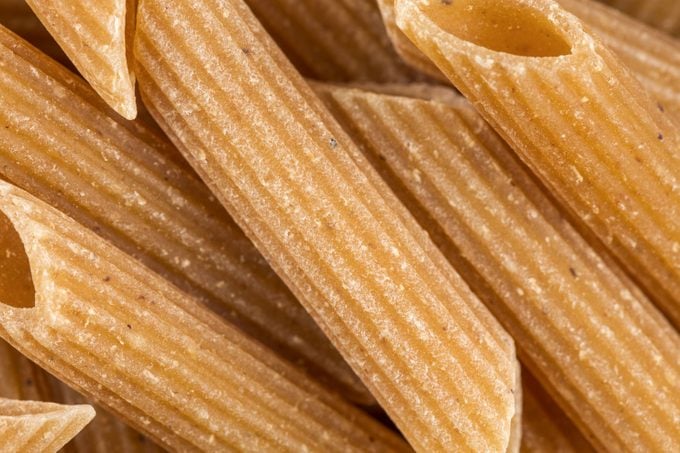I Ate Pasta Every Day for a Week—Here’s What Happened
Updated: Jul. 25, 2024

Here's the pasta-eating discovery our senior health editor made that shockingly led to some noticeable trimming-down, with some science (and a little Italian flare) to explain it.
We’d finally reached that window after the holidays when you find the discipline to slide into your routine again—but who needed discipline when my parents decided to come and visit us in February for the first time since we moved to San Francisco last year? They’d been cooped up for the Pennsylvania winter, and on a group text we had so much fun brainstorming all the outdoor restaurants my husband and I would take them to.
When they arrived we had a ball, including on the patio of an adored neighborhood pub where we watched the Super Bowl…right after we’d just been to brunch at the diner my husband and I love. Do we enjoy life? We do, and science says that’s arguably one of the secrets of longevity. But between prepping our new house for their visit, spending every minute with them that we could, and exploring legendary Bay Area bars and a few of our personal favorite restaurants, safe to say gym time hadn’t been a priority for a couple weeks. Everything from small plates to big steaks, we savored.
After a four-day weekend of consuming extra salt and fat from restaurant meals, including Friday night Chinese delivery (which doesn’t exist back home!), by the time my mom and dad caught their 6 a.m. Uber back to the airport, I was feeling both disappointed it was over…as well as a little puffy. My face, my hands, my belly: It was evident, and I wasn’t feeling my best.
It didn’t help that the day after they departed, along came Valentine’s Day. We had to have a little something special. Italian was the one type of fare we hadn’t crossed off our list during my family’s visit. Pesto gnocchi and rigatoni in vodka sauce it was.
Early the next morning, my husband took off for a long weekend to visit his side of the family while I stayed home to do the most sedentary activity in the world: Work on my book. I was on a publisher deadline and needed to make the most of a quiet weekend with only our two dogs to keep me company.
The morning he flew out, I felt mildly queasy, some headache, and my cheeks and eyeballs felt warm with fever, like I was fighting off some version of the flu. Two COVID tests were negative, but the rainy weekend forecast was all the permission I needed to snuggle up on the couch and take it easy for a couple days.
Who can eat pasta every day?
There’s an answer: the Italians. I was 26 the first time I visited my great-grandparents’ native Italy and was stunned to learn that the Italians could eat pasta literally every day and still manage to stay so collectively trim. It seemed that old Sophia Loren quote was true: “Everything you see, I owe to spaghetti.” Just…how?!
I was, and still am, convinced that the ingredients in Italian-made pasta are different than U.S.-made pasta. Some quick research suggests that’s true: Many homemade pasta recipes in Italy call for “double-zero” flour, which is said to have less gluten than American all-purpose flour. Also, many Italians often eat fresh pasta. (Living in Italy for a year, I learned to think of the word pasta as a translation of our paste, or what we call “dough.”)
The following summer when I moved to Italy, I also learned that their pasta preparation is so thoughtful and intentionally delicious that a single serving size is enough. People in Italy measure out their dry pasta and multiply one serving by however many people it will need to feed before they drop it into boiling water. This way, everybody gets their share and all are less likely to be tempted to reach for another heaping helping.
I didn’t pick up that practice, exactly, but hey: That’s why I’m Italian-American.
How I ate pasta every day
The day following our Valentine’s dinner delivery before my husband turned in early to catch a 7 a.m. flight, I was trying to think of what we had in the house that might help me fend off whatever illness I was feeling. In the pantry I discovered some Italian-made armoniche pasta, a large roundish noodle whose name is inspired by a harmonica with wavy ruffles, which we’d recently bought from World Market.
Research has shown that ingredients in chicken soup really can support immunity, but by the time my hunger hit, I wasn’t sure whether we had chicken and didn’t feel up to making much of anything from scratch. I wanted something fast for my stomach, and flavorful for my tastebuds. That’s where another culinary trick I’d learned from the Italians came in, which is to always have bouillon cubes on hand. Some people in northern Italy boil their rice in flavored broth…then, sometimes, they add parmesan or fontina cheese. (This is the ultimate comfort dish.)
Feeling crummy, I didn’t even crave the cheese (unusual for me). I just wanted some pasta boiled in chicken broth, which I anticipated would feel gentle on my belly and hopefully give me a little immune boost. I curled up with my bowl, which immediately hit the spot.
The next day I was feeling well enough after five hours of writing to take a rainy late-day walk to the park with our younger dog, but I still wanted to take it easy on my system. I also didn’t want to venture out for fresh produce: I’d reached the point when I was “in the zone” with my writing and could not let anything distract me. (Even washing the dishes suddenly seems like the most interesting task in the world when I have a deadline to meet. I have to guard myself so well against procrastination.)
Again, by the time I got hungry, I needed something fast without fuss…and I also wanted to start getting back into my more conscious routine with food. I remembered we had a box of chickpea pasta, which is a regular on our grocery list. I cooked the box’s full contents, again in chicken broth and this time with parmesan cheese stirred throughout my bowl.
No, it didn’t deliver quite the same satisfaction as “real” pasta. While most experts say chickpea pasta is considered to deliver the same serving of vegetables as chickpeas do—and while chickpeas are considered one of the 10 “perfect proteins“—in my experience chickpea pasta tends to be a little dry to the bite. That is, unless, you cook it just a minute too long, at which point it swiftly turns to mush.
Still, I love chickpea pasta because it’s a nutrition-friendly alternative to traditional pasta and sometimes I just need the feeling of that bowl sitting in front of me. As a health editor who reads nutrition labels carefully, Chickapea chickpea pasta is my favorite brand because it contains zero additives besides chickpea flour and lentil flour. Chickapea also happens to be made in Italy. (Living with two Italian families for a year, I learned that many Italians, too, seek alternatives to traditional wheat pasta; in part because celiac disease pops up in some regions.)
On day four of eating pasta, I needed to remain hunkered down to write. Glancing into the the pantry, I discovered a bag of red lentil pasta we’d gotten from Trader Joe’s. I pulled a bag of turkey meatballs out of the freezer and cooked them on simmer in the contents of two small jars of Trader Joe’s roasted red pepper and almond pesto sauce. I ate a bowl—it was wonderfully filling—then added my leftover chickpea pasta from the day before to the leftovers from this lentil pasta dish in red sauce. That would yield meals for the next two days.

What I discovered on day three of eating lentil pasta flabbergasted me. Traditional wheat pasta had helped give me comfort when I hadn’t been feeling well, while chickpea pasta had delivered vegetables in non-perishable form when I needed to skip grocery shopping.
After a few days of eating lentil pasta, I realized the bloat in my stomach was gone. Both Chickapea pasta and Trader Joe’s red lentil pasta are generous sources of natural fiber and prebiotics (providing six grams and three grams per serving, respectively). That, combined with the plant-based protein from each, apparently had helped flush my system. All this also fueled me enough to write 2,000 words a day, which is double my already-ambitious daily quota.
I’ll add that this daily pasta venture isn’t for every stomach: All that fiber was evident to me after a couple days of eating vegetable-based pasta…my system was clearly on cleanse. But if you can have your pasta and trim your tummy too, these varieties might be worth a try.
Keep a happy belly and a healthy system when you subscribe for FREE to The Healthy by Reader’s Digest newsletter and follow The Healthy on Facebook and Instagram. Keep reading:
- I Ate Tofu Every Day for a Week—Here’s What Happened
- Managing Blood Pressure? Eating These 2 Fruits Might Lower Mortality Risk, New Study Says
- Best Way To Keep Weight Off? Walk This Many Steps, Says New Study
- “Here’s How I Knew I Had Melanoma”: One Cured Patient’s Story Celebrating Medical Advancement




















